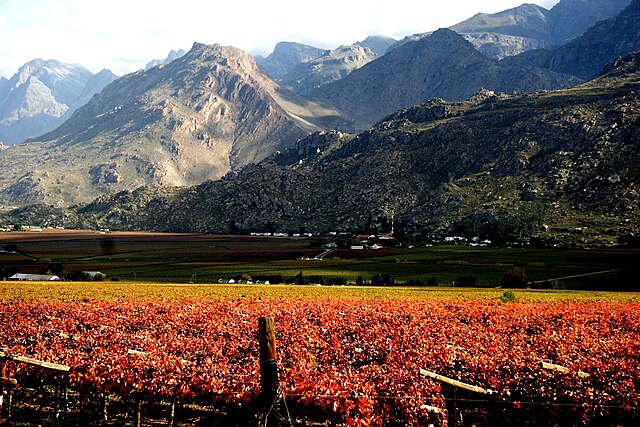After a weather-embattled 2024 harvest, the South Africa wine industry is hopeful for the 2025 season. The sector aims to recoup the impressive 2023 run that brought 934 million liters in processed wine.
The hopeful note sidelines the situation in the floods-hit 2024 when vineyard production fell by 7% from 2023’s.
For one, Dr. Etienne Terblanche of Vinpro Consultation Services cites that the currently fair weather turnaround could nurture strong vines for the upcoming season.
On his part, Rico Basson, the chief executive for South Africa Wine foresees a successful 2025 harvest, which will strengthen future sustainability. This according to an October 16 , 2024 report on Harpers UK.
Indeed, the foregoing winter has brought in extra rain millimeters across most of the 10 wine-producing regions of the country.
Besides, the chilling conditions that are essential for building moisture reserves to harvested grapevines have been optimal and frost-free.
Farmers have also learned their lesson not to prune the vines before frost has fallen so as to prevent budding damage. This season, pruning has begun very late into the winter, a precaution that will bring uniform budding during spring.
The only disquieting factor is whether bunch formation will again fall prey to adverse weather and impact fruit size.
Bunching in grapevines not only determines flowering patterns but the size of the bunches that carry fruits. Hence it is critical that there be consistent weather during this development stage.
Similar bunching issues affected table grapes in early 2024, whereby neighboring Namibia supplanted South Africa as the continental supplier.
But if all goes according to expectations, the South Africa wine sector could recoup its clout that it last enjoyed in 2023.
2023’s exports reached 306 million liters or 32.7% of the total production and amassed 10 billion Rand ($565.6 million) in turnover.
Thus, it is only a matter of time before Western Cape and other coastal wine regions recover from weather effects. To learn more about wine production in the wine leader of Africa, skim the statistics below.
South Africa Wine Statistics
South Africa’s wine classifies among the most premium in the world with the likes of Italy, Spain and France. In 2021, the country produced 1,133,300 kiloliters (kl) of wine, the tenth highest worldwide after Italy’s lead of 5,088,500 kl. By 2023, South Africa’s ranking had improved to the seventh position with 930,000 kl, behind France’s lead.
What is the ratio of grape output versus wine production in South Africa?
While some fruits do not undergo processing and instead serve as table grapes, around 50% of South Africa’s grapes reach wineries. In 2021, for instance, the country produced 2,000,297 tonnes of grapes according to FAOSTAT, while its wine output reached 1,133,300 tonnes or kl.
How big is the wine area in South Africa?
The country had 114, 622 hectares of grapes in 2021, which rose to 117,386 hectares in 2022. The total length of the landmass under wine groves in South Africa runs to around 800 km.
Which are the key wine regions?
There are 30 administrative districts that produce grapes, most of which on the coastline of the Cape region. The main geographical demarcations, which also feature under the Wine Origin Scheme include Northern Cape, Eastern Cape and the Coastal Region. Rainfall here is usually at 1,000 mm per year, which is the optimum for perennial grapevine recycling.
